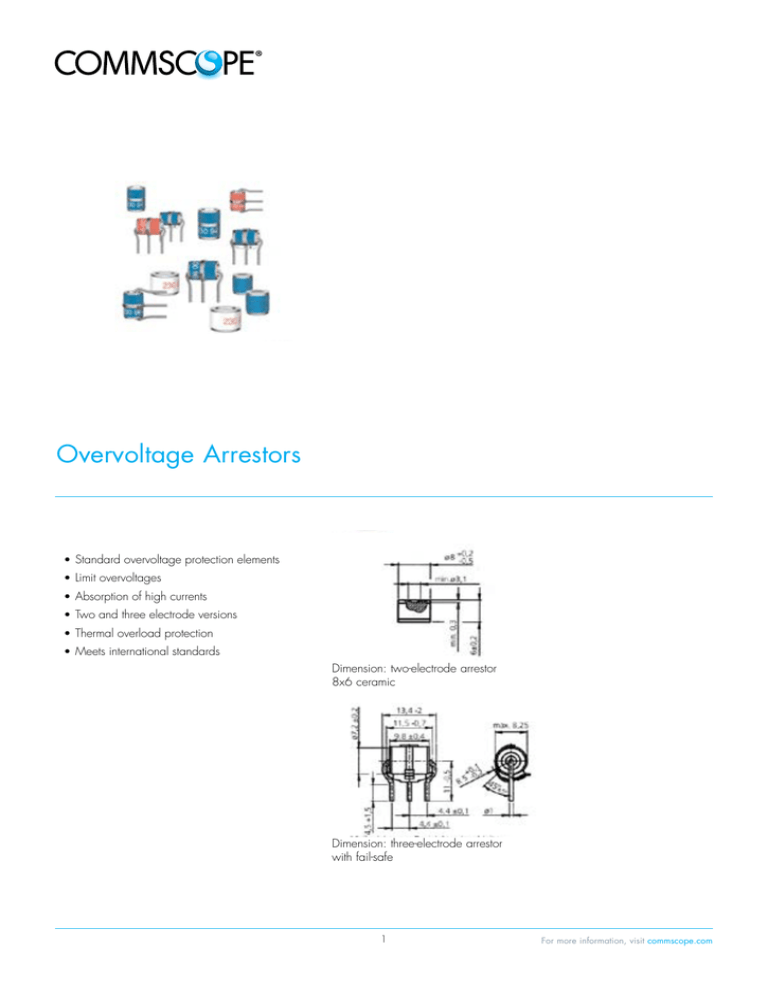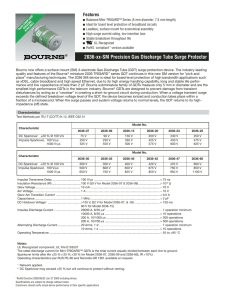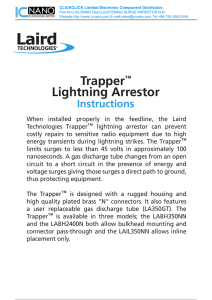
TECHNICAL DATA
Overvoltage Arrestors
Overvoltage Arrestors
• Standard overvoltage protection elements
• Limit overvoltages
• Absorption of high currents
• Two and three electrode versions
• Thermal overload protection
• Meets international standards
Dimension: two-electrode arrestor
8x6 ceramic
Overvoltage Arrestors
Dimension: three-electrode arrestor
with fail-safe
www.adckrone.com
•
+49-30-8453-0
•
+49-30-8453-1703
www.te.com/bns
• Standard overvoltage protection elements
• Limit overvoltages
• Absorption of high currents
• Two and three electrode versions
• Thermal overload protection
• Meets international standards
Dimension: two-electrode arrestor
8x6 ceramic
Dimension: three-electrode arrestor
with fail-safe
www.adckrone.com
•
+49-30-8453-0
•
+49-30-8453-1703
www.te.com/bns
1
For more information, visit commscope.com
Overvoltage Arrestors
Overvoltage Arrestors
Advanced communications technology, as well as
measuring and control systems call for perfect signal
transmission. In order to eliminate any risk of personal
injury and damage to or even destruction of
installations as a consequence of overvoltage
conditions, these influences must be limited to harmless
levels by means of overvoltage arrestors.
Overvoltage conditions are distinguished in terms of
internal and external overvoltages:
Internal overvoltage conditions occur as a
consequence of:
• switching of inductive circuits
8/05
Overvoltage Arrestors
• spark-over
• conductive coupling with higher voltage
potentials
• influences of other components
(approximately 20 to 40V), a further build-up of the
overvoltage. After the influence has decayed, the
arc in the GDT is interrupted (arc extinction) and the
internal resistance of the component immediately
rises to a value of >1000MΩ.
In practical application, the GDT is connected in
parallel with the information transmission system to
be protected (Figure 3). Its internal resistance is
extremely high at operating voltage and falls to
nearly <0.1Ω when an overvoltage condition
occurs, thereby shorting the operating voltage and
the overvoltage. In common telecommunication
circuits and/or systems with an operating voltage of
less than 60 VDC, the GDT's arc extinction is
ensured after elimination of the influence. In the case
of systems with an operating voltage of more than
60 VDC or with lower impedance, the GDT's
extinction behaviour must be checked case by case.
If, for instance, GDTs are used in conjunction with
power or voltage supply systems (e.g. main sockets),
precise examination of the extinction behaviour is
mandatory.
External overvoltage conditions impact the
system:
• through connecting lines
• in the form of inductive coupling caused, for
instance, by fields of a power supply line or
switching process
• in the form of capacitive coupling caused, for
instance, by atmospheric fields
Operation
The operation of overvoltage arrestors (gas
discharge tubes, GDTs) is based upon highly
efficient gas discharge principles. In electrical terms,
a GDT behaves like a voltage-controlled switch
(Figure 2). As soon as the overvoltage exceeds the
GDT's spark-over voltage, a defined discharge
occurs in the component. The hermetically sealed
GDT's electrical specifications are highly dependent
upon certain parameters, such as gas type, gas
pressure and spark gap. The discharging process
destroys the energy within a short time. With its
high current carrying capacity, the arc thus
generated prevents, at more or less constantly low
arc voltage
Optimally, the GDT meets the requirements of a
protection element: the overvoltage is safely limited
to permissible levels, and due to its high insulation
resistance and very low self-capacitance (<5 pF)
under undisturbed conditions, the GDT has virtually
no influence on the protected system.
In addition to the parameters mentioned above, the
degree of primary ionization of the enclosed gas
volume plays a crucial role in considering the rise
time of the GDT during initial firing.
Without primary ionization of the gas volume, the
initial ignition in the GDT (dark discharge effect) is
delayed. The use of additional ionization sources
(subject to special specification) reduces the ignition
level during initial ignition.
The response behaviour of the GDT is greatly
influenced by the rate of rise of the interference
influence. The response time of the GDT is generally
defined in the 0,1 µs range, with the
Activating compound
Electrodes
Figure 2: Characteristic and principles of
GDT construction
Ceramic or
glass insulator
www.adckrone.com
•
Ignition aid
Gas discharging space
+49-30-8453-0
2
•
+49-30-8453-1703
2
For more information, visit commscope.com
Overvoltage Arrestors
Overvoltage Arrestors
previously mentioned rate of rise of the overvoltage
playing the most important part in which context the
response voltage ranges for “static“ and “dynamic
interference influences“ are distinguished (Figure 4).
In the case of a dynamic influence (steeper
voltage waves) the GDT's firing voltage is above the
response DC voltage (VSi > VcdcN) that is due to the finite
ionization time of the gas.
Push-pull interferences due to non-synchronous ignition of
the discharging distance (against earth) are avoided
through the use of three-electrode arrestors. A common
discharging space ensures almost simultaneous ignition
events at different interference levels.
GDTs are exclusively designed for transient loads
(see ITU recommendation K12).
A GDT exposed to permanent loads (e.g. under power
crossing conditions [influence due to contact of the
system to be protected with power and voltage supply
systems]), will be destroyed by overheating. Threeelectrode arrestors with external temperature protection
(fail-safe) can be used in order to prevent damage to
installations and overvoltage protection equipment as a
consequence of over-temperature of the GDT. In such a
case, an external short-circuit bridge shorts the
overheated GDT against earth.
Specifications
A wide range of GDTs is available for the most
varied applications.
The most important distinctions are:
• two-electrode arrestor (button type) or threeelectrode arrestor
• material: ceramic (MK)
• geometrical arrestor dimensions
GDTs are additionally defined by the following
electrical characteristics:
• The nominal dc spark-overvoltage (VSdcN)
defines the static value of the GDT's ignition point
(in Volts). By definition, this value is determined by
u
a voltage (rate of rise: d /dt = 100 V/s). The
standard VSdcN tolerance is ±20%.
• The impulse spark-overvoltage (VSi) defines the
typical value of the GDT's dynamic ignition point
(in Volts) (voltage rise by definition 1 kV/µs).
• The nominal alternating discharge current
(IdaN) is defined as a 1s AC current (50Hz, RMS
value).The GDTs are designed to withstand either
ten loading processes (every 3 minutes) in
accordance with ITU K12, or five loading
processes (every 30 seconds) in accordance with
DIN/VDE.
• The nominal impulse discharge current (idiN)
defined as current impulse with 8/20µs
waveform. The GDTs are designed to withstand
the following loads: in accordance with ITU K12:
ten times (every 3 minutes) or in accordance with
DIN/VD: five times (every 30 seconds).
In addition to these characteristics, standard data
are available concerning the capacitance of the
GDTs (typically 2 pF) and their insulation resistance
11
Risol Risol (>10 Ω).
Figure 3: Line
protection with
GDTs (in parallel
with load)
dynamic range
static range
Figure 4: GDT
response behaviour
(example
VcdcN=230V)
www.adckrone.com
•
+49-30-8453-0
•
3
www.te.com/bns
+49-30-8453-1703
3
For more information, visit commscope.com
3
Overvoltage Arrestors
Product range of overvoltage arrestors*
Two-electrode arrestors
Vsi/V
<600
<600
<600
<700
<700
<700
<1000
IdaN//A
20
10
20
10
5
20
10
IdiN/kA**
20
10
20
10
5
20
10
Catalogue Number
6717 3 341-00
6717 3 341-01
6717 3 343-00
6717 3 343-01
6717 3 343-03
6717 3 344-00
6717 3 344-01
Three-electrode arrestor without Fail-safe
Type
VscicN/V
Arrestor 8x13, 90V
90
Arrestor 8x13, 230V
230
Arrestor 8x13, 230V
230
Arrestor 8x13, 350V
350
Arrestor 8x13, 350V
350
Vsi/V
<550
<650
<450
<900
<700
IdaN//A
10
10
10
10
10
IdiN/kA**
10
10
20
10
10
Catalogue Number
6717 3 501-00
6717 3 503-00
6717 3 503-01
6717 3 504-00
6717 3 504-01
Three-electrode arrestor with Fail-safe
Type
VscicN/V
Arrestor 8x13, FS, 90V
90
Arrestor 8x13, FS, 230V
230
Arrestor 8x13, FS, 230V
230
Arrestor 8x13, FS, 350V
350
Vsi/V
<550
<650
<450
<900
IdaN//A
10
10
10
10
IdiN/kA**
10
10
20
10
Catalogue Number
6717 3 511-00
6717 3 513-00
6717 3 513-90
6717 3 514-00
Type
Arrestor 8x6, 90V
Arrestor 8x6, 90V
Arrestor 8x6, 230V
Arrestor 8x6, 230V
Arrestor 8x6, 230V
Arrestor 8x6, 350V
Arrestor 8x6, 350V
VscicN/V
90
90
230
230
230
350
350
*) Arrestors with different design and other electrical
Line A/ Line B, earth:
**) VsdcN/V
Line A/Line B, earth:
Vsi/V
Line A and Line B, earth:
IdaN/A
Line A and Line B, earth:
idiN/kA
properties on request.
100 V/s
1000 V/µs
50 Hz 1 s
8/20 µs
DC spark-over voltage
vsdc/V
Line A/Line B, earth:
100V/s
Impulse spark-over voltage
vsi/V
Line A/Line B, earth:
1000V/µs
Alternating ac discharge current
IdaN/a
Line A and Line B, earth:
50Hz 1s
Impulse discharge current
idiN/a
Line A and Line B, earth:
8/20µs
Internet: www.adckrone.com
For a listing of our global sales office locations, please refer to our web site.
ADC GmbH, Beeskowdamm, 3-11, 14167 Berlin, Germany
Phone: +49 30 8453-0 Fax: +49 30 8453-1703
Specifications published here are current as of the date of publication of this document. Because we are continuously
improving our products, ADC KRONE reserves the right to change specifications without prior notice. At any time, you may
verify product specifications by contacting our world headquarters office in Minneapolis. ADC Telecommunications, Inc. views
its patent portfolio as an important corporate asset and vigorously enforces its patents.
www.commscope.com
101259EN 8/05 Original © 2005 ADC Telecommunications, Inc. All Rights Reserved
Visit our website or contact your local CommScope representative for more information.
© 2015 CommScope, Inc. All rights reserved.
All trademarks identified by ® or ™ are registered trademarks or trademarks, respectively, of CommScope, Inc.
This document is for planning purposes only and is not intended to modify or supplement any specifications or
warranties relating to CommScope products or services.
PS-101259-EU (10/15) [Revised from 101259EN]







